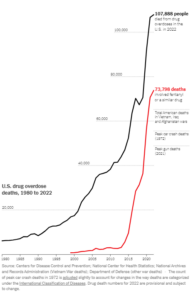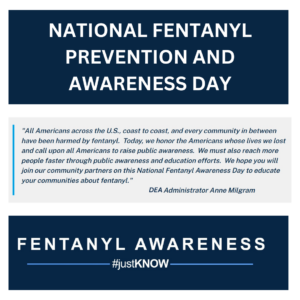
In recent years, the opioid crisis has plagued communities across the globe. Among the many substances contributing to this epidemic, one stands out as particularly lethal: fentanyl.
This synthetic opioid, originally developed for medical purposes, has found its way into the illicit drug market, leading to a staggering rise in overdose deaths and having a devastating effect on individuals, families, communities, healthcare systems, first responders, law enforcement, and economies.
Fentanyl: The Lethal Synthetic Opioid
Fentanyl is a synthetic opioid that was first synthesized in the 1960s for medical use. It is highly potent, estimated to be 50 to 100 times more powerful than morphine and up to 50 times stronger than heroin.
Initially, it was developed to manage severe pain in patients with terminal illnesses or undergoing major surgeries. When used appropriately and under strict medical supervision, it can be an effective pain management tool. However, the shift from legitimate medical use to illicit recreational use has led to an alarming public health crisis.
Illicit Production and Distribution of Fentanyl
One of the major dangers of fentanyl is its widespread availability. Access to it is not limited to highly populated areas, or any particular geographic, economic, or ethnic group. It is in every state, city, and town in the United States.
Illicitly produced fentanyl is sold illegally under various names. Its affordability and potency make it an ‘attractive’ option for drug dealers and users alike. Dealers often mix fentanyl with other drugs such as heroin, cocaine, or counterfeit prescription pills, increasing the risk of overdose.
The potency of fentanyl poses a significant risk because even a miniscule amount, as little as 2 milligrams, can cause a deadly overdose. In many cases, users are unaware that they are consuming fentanyl, as it is often added to other drugs without the user’s knowledge.
The Danger of Accidental Overdose
One of the significant dangers associated with fentanyl is the high risk of accidental overdose. Due to its potency, even a tiny miscalculation in dosage can have fatal consequences. Many people who use fentanyl do not have the necessary knowledge or equipment to measure precise doses, making it easy to ingest a lethal amount unknowingly.
Additionally, fentanyl has a rapid onset of action, which means that users may not have time to react to the overdose symptoms before it’s too late.
Common signs of a fentanyl overdose include:
- Slowed breathing
- Extreme drowsiness
- Confusion
- Pinpoint pupils
- Cold, clammy, or discolored skin
- Limp body
- Unconsciousness
Without immediate medical intervention, these symptoms can quickly lead to respiratory failure and death.
The Devastating Impact of Fentanyl
The opioid crisis fueled by fentanyl has had a devastating impact on individuals, families, and communities. The rising number of overdose deaths is a grim reminder of the urgency of addressing this crisis. Not only does fentanyl put users at risk, but it also affects first responders, healthcare professionals, and law enforcement personnel who are frequently exposed to the drug while trying to save lives.
Moreover, the economic toll of the opioid epidemic is staggering. The costs associated with healthcare, addiction treatment, criminal justice, and lost productivity are enormous, straining already limited resources in many regions.
Fentanyl and the Role of Prescription Opioids
It’s important to note that the opioid crisis, including the proliferation of fentanyl, has roots in the overprescribing of opioid pain medications. Many people who become addicted to opioids, including fentanyl, initially develop their dependence through prescription medications. When their prescription runs out, or becomes too expensive, they may turn to the dangerous illicit market.
Addressing the Dangers of Fentanyl
Addressing this public health crisis requires a multifaceted approach that involves prevention, education, treatment, and policy changes, including bringing public awareness to the dangers of fentanyl by highlighting prevention and action days May 7th and August 21st each calendar year.
- Prevention: Preventing fentanyl overdoses starts with reducing the demand for the drug and increasing awareness on the dangers. This includes initiatives to reduce overprescribing of opioid pain medications, implementing drug education programs, and raising public awareness about the risks of fentanyl.
- Naloxone: Providing access to naloxone (known commonly as Narcan), an opioid overdose reversal medication, can save lives. Distributing naloxone kits to at-risk individuals and their loved ones can be crucial in preventing fatal overdoses.

- Treatment: Accessible and effective addiction treatment services are essential to helping individuals overcome opioid addiction, including inpatient and outpatient programs, sober housing options, counseling, and support programs.
- Law Enforcement and Regulation: Stricter regulation and law enforcement efforts are needed to curb the illicit production and distribution of fentanyl. Identifying and prosecuting drug traffickers who profit from this deadly trade is essential.
- Public Awareness and Education: Continued public awareness campaigns are necessary to educate people about the dangers of fentanyl and the importance of seeking help.
Fentanyl, with its unmatched potency and widespread availability in the illicit drug market, has become a major contributor to the opioid crisis. Its dangers extend beyond individual users to affect entire communities and economies.
To combat the devastating impact of fentanyl, we must work collectively to implement prevention, education, treatment resources, and law enforcement strategies. Only through a comprehensive approach can we mitigate the dangers of fentanyl and save lives.
About Herren Wellness
Herren Wellness is a thriving community of people at all stages in their recovery journey. We introduce holistic therapies and strategies centered around emotional, physical, and spiritual wellness, in addition to life coaching sessions, family support and an individualized wellness plan to provide a solid foundation in recovery from alcohol and substance use.
We believe that staying connected and community has a lasting impact on recovery, and encourage all alumni to participate in our weekly alumni meetings, seasonal events and annual retreat. Your connection to Herren Wellness doesn’t end when your stay ends; we are there for you throughout your recovery journey.

If you, or a loved one, are looking for help, please call us at (844) 443-7736, email us at info@herrenwellness.com, or register for a 30 minute consultation with our Executive Director, Lori McCarthy. It is never too early or to late to seek help for substance use at any stage.





